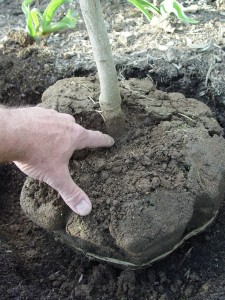Rethinking the Way We Plant, Part 2
April 9th, 2013
I was reading some old gardening books lately and was dumbfounded by how so much planting advice is now just the opposite of what was the “expert advice” just a generation or two ago.
It makes me wonder what experts are going to be saying a generation or two from now. Did we get it right this time? Or was the earlier advice on planting a tree or shrub right after all? Or maybe both we and the oldsters will turn out to be morons by 2050.
Last week I told you about some of the new thinking on dealing with the alleged soil at the planting site.
Read Rethinking the Way We Plant, Part 1
Here are eight other planting steps that, at least for now, are supposed to be the right ones:
1.) Skip the high-phosphorus fertilizers that supposedly encourage root growth. Just go with native soil and water, and if anything, a little nitrogen fertilizer, such as fish meal or fish emulsion.
2.) Remove all burlap, twine, baskets and any other packaging material from your new plant’s roots before planting. In fact, some are recommending to even remove the soil in the pot and burlap bag so the roots go right into the new soil (see last week’s post).
3.) Locate the point low on the trunk where the trunk flares out and transitions into the root zone. Then make sure that point stays slightly above grade. This “root flare” or “shoot-root interface” should never be buried. Be aware that it’s sometimes already covered by soil in the nursery pot or burlap bag.

Find where the base of the trunk begins to flare out into the root zone and make sure that point is just above grade.
4.) Don’t prune off the top growth to “bring the branches into balance with the roots.” Only prune off broken branches at planting. The top growth is what will produce the energy that the roots need to grow, so lopping them off reduces the plant’s energy “factory” right off the bat.
5.) If you’re planting a single tree or shrub, build a berm around the hole’s perimeter to guide water into the root zone.
6.) Stake lightly, if at all, and only for the first year. Attach the supports about one-third of the way up with soft materials that won’t cut into the bark. Letting the trunk sway a bit encourages the roots to establish quicker.
7.) Wrap wire cylinders around the trunks 2 to 3 feet up to prevent rodents from girdling the tender, young bark and killing the whole plant after you’ve done everything else right. Animal damage is an underrated cause of plant loss in our rabbit-, vole-, chipmunk-, mice- and deer-infested area.
8.) Keep the soil consistently damp but never soggy for at least the first full season, and your odds will get better day by day. Soil moisture is especially critical in those first few years.
Do a good job with all of these, and when your new maple is still alive in 2050, no one can say you were a total moron.








